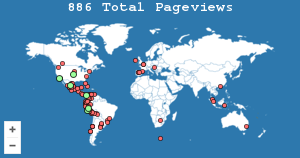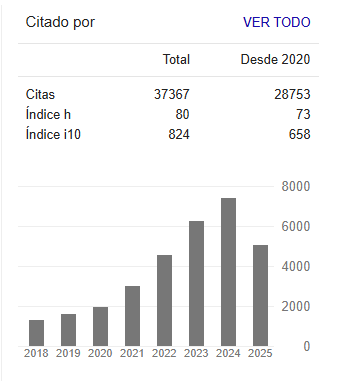Innovación y desempeño empresarial: Estudio bibliométrico
Resumen
El objetivo del estudio fue investigar la innovación y su influencia en el rendimiento empresarial mediante análisis bibliométrico de la producción científica desde el año 2000 al año 2022. Se procedió a revisar publicaciones científicas especializadas en la base de datos Web of Science. Se identificaron un total de 1996 documentos, de las cuales se seleccionó una muestra base de 548 para el desarrollo del análisis bibliométrico. Se analizó la contribución científica internacional. Se examinó la producción anual científica, las revistas con más publicaciones, la producción por país, los documentos más citados, las palabras más relevantes, la red de palabras claves utilizadas por los autores, la red de colaboración por países, entre otras variables. Los resultados destacaron que la producción científica más significativa fue entre 2018 y 2021, con 344 registros. La mayor producción la tuvieron China con 591 y los Estados Unidos con 460 productos. El autor más citado es Teece, D.J. con 4,794 citas, seguido de Jiménez-Jiménez, D. con 650, y Matsuno, K. con 498. Se concluyó que la innovación impacta el rendimiento empresarial con una tendencia ascendente porque fortalece el desarrollo de las organizaciones.
Citas
• Alegre, J., Ferreras-Méndez, J., Fernández-Mesa, A., & Strange, R. (2022). Innovation capabilities and export performance in manufacturing SMEs. Tec Empresarial, 16(3). http://dx.doi.org/10.18845/te.v16i3.6367
• Ali, F., Ali, M., Malik, S., Hamza, M., & Fawad, H. (2020). Managers’ Open Innovation and Business Performance in SMEs: A Moderated Mediation Model of Job Crafting and Gender. Journal of Open Innovation: Technology, Market, and Complexity, 6(3). https://doi.org/10.3390/joitmc6030089
• AlMuhayfith, S., & Shaiti, H. (2020). The Impact of Enterprise Resource Planning on Business Performance: With the Discussion on Its Relationship with Open Innovation. Journal of Open Innovation: Technology, Market, and Complexity, 6(3). https://doi.org/10.3390/joitmc6030087
• Artz, K., Norman, P., Hatfield, D., & Cardinal, L. (2010). A Longitudinal Study of the Impact of R&D, Patents, and Product Innovation on Firm Performance. Journal of Product Innovation Management, 27(5), 725-740. http://dx.doi.org/10.1111/j.1540-5885.2010.00747.x
• Barber, D., Peake, W., & Harris, M. (2022). Can playing defense yield gains? Examining the relationships among regulatory focus, innovation, and SME performance. Journal of Small Business Management. https://doi.org/10.1080/00472778.2022.2141762
• Bashir, M., Alfalih, A., & Pradhan, S. (2022). Sustainable business model innovation: Scale development, validation and proof of performance. Journal of Innovation & Knowledge, 7(4). https://doi.org/10.1016/j.jik.2022.100243
• Berastain, L. (2009). Aprender a innovar en una pyme. Paidós.
• Boateng, H., Sigdel, S., Simpe, K., Agbemabiese, G., & Hinson, R. (2022). Assessing the roles of foreign knowledge acquisition and absorptive capacity in the relationship between market orientation, innovativeness and performance. Management Research Review. https://doi.org/10.1108/MRR-10-2021-0726
• Ceccagnoli,, M., & Rothaermel, F. (2016). Appropriability Strategies to Capture Value from Innovation. https://doi.org/10.1108/S1048-473620160000026001
• Chatterje, D., & Sahasranamam, S. (2018). Technological Innovation Research in China and India: A Bibliometric Analysis for the Period 1991-2015. Management and Organization Review, 14(1), 179-221. https://doi.org/10.1017/mor.2017.46
• Chesbrough, H. (2003). Open Innovation The New Imperative for Creating and Profiting from Technology. Harvard Business School Publishing Corporation.
• Cooper, R. (1988). The New Product Process: A Decision Guide for Management. Journal of Marketing Management, 3(3), 238-255. http://dx.doi.org/10.1080/0267257X.1988.9964044
• Covin, J., & Walles, W. (2012). The Measurement of Entrepreneurial Orientation. Entrepreneurship Theory and Practice, 36(4). https://doi.org/10.1111/j.1540-6520.2010.00432.x
• Cuevas-Vargas, H., Estrada, S., & Larios-Gómez, E. (2016). The Effects of ICTs As Innovation Facilitators for a Greater Business Performance. Evidence from Mexico. Procedia Computer Science, 91, 47-56. https://doi.org/10.1016/j.procs.2016.07.040
• De Avila, J., Zawislak, P., & Correa, H. (2015). Searching for a paht: a bibliometric study on innovation and technological capabilities. International Journal of Innovation, 3(2), 54-66.
• Eiadat, Y., Kelly, A., Roche, F., & Eyadat, H. (2008). Green and competitive? An empirical test of the mediating role of environmental innovation strategy. Journal of World Business, 43(2), 131-145. https://doi.org/10.1016/j.jwb.2007.11.012
• Farida, I., & Setiawan, D. (2022). Business Strategies and Competitive Advantage: The Role of Performance and Innovation. Journal of Open Innovation: Technology, Market, and Complexity, 8(3). https://doi.org/10.3390/joitmc8030163
• Franco-Santos, M., Kennerley, M., Micheli, P., Martínez, V., Mason, S., Marr, B., . . . Neely, A. (2007). Towards a definition of a business performance measurement system. International Journal of Operations & Production Management, 27(8), 784-801. http://dx.doi.org/10.1108/01443570710763778
• Golicic, S., & Smith, C. (2013). A Meta-Analysis of Environmentally Sustainable Supply Chain Management Practices and Firm Performance. Journal of Supply Chain Management, 49(2), 78-95. https://doi.org/10.1111/jscm.12006
• Griffin, A., & Page, A. (1993). An Interim Report on Measuring Product Development Success and Failure. 10, 291-308. https://doi.org/10.1016/0737-6782(93)90072-X
• Hughes, M., & Morgan, R. (2007). Deconstructing the relationship between entrepreneurial orientation and business performance at the embryonic stage of firm growth. Industrial Marketing Management, 36(5), 651-661. https://doi.org/10.1016/j.indmarman.2006.04.003
• Jiménez-Jiménez, D., & Sanz-Valle, R. (2011). Innovation, organizational learning, and performance. Journal of Business Research, 64(4), 408-417. https://doi.org/10.1016/j.jbusres.2010.09.010
• Kaldas, M., Michael, S., Hanna, J., & Yousef, G. M. (2020). Factor de impacto de las revistas: Un viaje lleno de baches en un espacio abierto. J. Investig. Med., (68), 83-87.
• Katsikeas, C., Leonidou, L., & Morgan, N. (2000). Firm-Level Export Performance Assessment: Review, Evaluation, and Development. Academy of Marketing Science, 28(4). https://doi.org/10.1177/0092070300284003
• Kim, D., & Jin, S. (2022). Innovation Capabilities and Business Performance in the Smart Farm Sector of South Korea. Journal of Open Innovation: Technology, Market, and Complexity, 8(4). https://doi.org/10.3390/joitmc8040204
• Kim, J. (2014). Scan and click: The uses and gratificacions of social recommendation systems. Computers in Human Behavior, 33, 184–191. https://doi.org/10.1016/j.chb.2014.01.028
• Le, H., Dao, Q., Pham, V.-C., & Tran, D. (2019). Global trend of open innovation research: A bibliometric analysis. Cogent Business &, 6(1). https://doi.org/10.1080/23311975.2019.1633808
• Lee, K.-H., & Min, B. (2015). Green R&D for eco-innovation and its impact on carbon emissions and firm performance. Journal of Cleaner Production, 108, 534-542. https://doi.org/10.1016/j.jclepro.2015.05.114
• Martínez, V. (2010). Challenges in transforming. Journal of Manufacturing Technology Management, 21(4).
• Matsuno, K., Mentzer, J., & Özsomer, A. (2002). The Effects of Entrepreneurial Proclivity and Market Orientation on Business Performance. Journal of Marketing, 66(3). https://doi.org/10.1509/jmkg.66.3.18.18507
• Moorman, C. (1995). Organizational Market Information Processes: Cultural Antecedents and New Product Outcomes. Journal of Marketing Research, 32(3), 318-335.
• Nambisan, S. (2013). Information Technology and Product/Service Innovation: A Brief Assessment and Some Suggestions for Future Research. Journal of the Association for Information Systems, 14(4), 215-226. http://dx.doi.org/10.17705/1jais.00327
• Organización de Cooperación y Desarrollo Económicos [OCDE]. (2018). Manual de Oslo. Guía para la recogida e interpretación de datos sobre innovación. (4a. ed). Tragasa.
• Rosário, C., Varum, C., & Botelho, A. (2022). Impact of Public Support for Innovation on Company. Sustainability, 14. https://doi.org/10.3390/su14084731
• Ruiz-Palomo, D., Santos, J., Palacios, M., & León-Gómez, A. (2022). Disentangling the impact of ICT adoption on SMEs performance: the mediating roles of corporate social responsibility and innovation. Oeconomia Copernicana, 13(3). http://dx.doi.org/10.24136/oc.2022.024
• Saliba, J., Cruz, L., Kimura, H., & Amorim, V. (2018). Innovation and financial performance of companies doing business in Brazil. International Journal of Innovation Studies, 2(4), 153-164. https://doi.org/10.1016/j.ijis.2019.03.001
• Sánchez-Perdomo, R., Rosario-Sierra, M., Herrera-Vallejera, D., Rodríguez-Sánchez, Y., & Carrillo-Calvet, H. (2017). Revisión bibliométrica de las Ciencias de la Información en América Latina y el Caribe. Investigación Bibiotecológica, 31, 79-100. https://doi.org/10.22201/iibi.24488321xe.2017.nesp1.57886
• Santarelli, E., & Vivarelli, M. (2007). Entrepreneurship and the Process of Firms Entry, Survival and Growth. Industrial and Corporate Change, 16(3), 455-488. http://dx.doi.org/10.1093/icc/dtm010
• Schumpeter, J. (1934). The Theory of Economic Development. Harvard University Press.
• Sharabati, A.-A., Jawad, S., & Bontis, N. (2010). Intellectual Capital and Business Performance in the Pharmaceutical Sector of Jordan. Management Decision, 48(1), 105-131. http://dx.doi.org/10.1108/00251741011014481
• Siguaw, J., Simpson, P., & Enz, C. (2006). Conceptualizing Innovation Orientation: A Framework for Study and Integration of Innovation Research. Journal of Product Innovation Management, 23(6), 556-574. http://dx.doi.org/10.1111/j.1540-5885.2006.00224.x
• Spohrer, J., & Maglio, P. (2008). The Emergence of Service Science: Toward Systematic Service Innovations to Accelerate Co‐Creation of Value. Production and Operations Management, 17(3), 238-246. http://dx.doi.org/10.3401/poms.1080.0027
• Šümakaris, P., Šceulovs, D., & Korsakiene, R. (2020). Current Research Trends on Interrelationships of Eco-Innovation and Internationalisation: A Bibliometric Anaysis. Journal of Risk and Financial Management, 13. https://doi.org/10.3390/jrfm13050085
• Teece, D. (2007). Explicating dynamic capabilities: the nature and microfoundations of (sustainable) enterprise performance. Strategic Management Journal, 28(13), 1319-1350. https://doi.org/10.1002/smj.640
• Volberda, H., Foss, N., & Lyles, M. (2010). Perspective—Absorbing the Concept of Absorptive Capacity: How to Realize Its Potential in the Organization Field. Organization Science, 931-951. https://doi.org/10.1287/orsc.1090.0503
• Wall, T., & Wood, S. (2005). The romance of human resource management and business performance, and the case for big science. Human Relations, 58(4), 429-462. http://dx.doi.org/10.1177/0018726705055032
• Wang, W.-Y., & Chang, C. (2005). Intellectual Capital and Performance in Causal Models Evidence from the Information Technology Industry in Taiwan. Journal of Intellectual Capital, 6(2), 222-236. http://dx.doi.org/10.1108/14691930510592816
• Wang, X. (2018). The effect of inbound open innovation on firm performance in japanese manufacturing firms: comparative study between research centre and business unit. International Journal of Innovation Management, 22(7), 1850054. https://doi.org/10.1142/S1363919618500548
• Web of Science. (2023). Web of Science. www.clarivate.com
• Wu, F., Mahajan, V., & Balasubramanian, S. (2003). An Analysis of E-Business Adoption and Its Impact on Business Performance. Journal of the Academy of Marketing Science, 31(4). http://dx.doi.org/10.1177/0092070303255379
• Yusof, N., Kamal, E., Ernawati, M., Lou, E., & Kamaruddeen, A. (2023). Effects of innovation capability on radical and incremental innovations and business performance relationships. Journal of Engineering and Technology Management, 67. https://doi.org/10.1016/j.jengtecman.2022.101726
• Zhang, X., Chen, H., Wang, W., & Ordóñez, P. (2016). What is the role of IT in innovation? A bibliometric analysis of research development in IT innovation. Behaviour & Information Technology, 35(12), 1130-1143. https://doi.org/10.1080/0144929X.2016.1212403

Esta obra está bajo licencia internacional Creative Commons Reconocimiento-NoComercial-CompartirIgual 4.0.








.png)






























